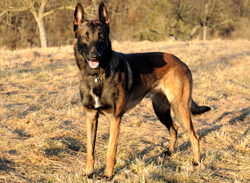The Belgian Malinois is an alert and high-energy breed that is often confused with the German Shepherd. However, Malinois dogs are lighter-boned while still being strong and agile. These medium-sized dogs have a short coat that is straight, hard, and weather resistant. It is very short on the lower legs, head, and ears. The breed's color ranges from fawn to mahogany, and these dogs have a black mask and ears, along with black tips on their hairs. The undercoat is dense. The body is well balanced and square, but elegant in appearance, and the eyes are medium, dark brown, and alert. The Belgian Malinois stands 22 to 26 inches tall at the shoulder and weighs 40 to 80 pounds. These dogs live up to 14 years.
They need a significant amount of time outside to run and play.
The Belgian Malinois breed is intelligent and affectionate and makes a great addition to active households. Because of their high energy levels, these dogs don't do very well in apartments or small homes. They need a significant amount of time outside to run and play.
When confined to a yard or other space, these dogs often begin running in large circles. This may look strange to onlookers. The action is an outlet for excess energy and is a herding behavior.
Intelligent and confident dogs, Belgian Malinois dogs are happiest when busy with a task. They delight in helping with household chores, and bore easily without something to occupy them both physically and mentally.
These dogs are adaptable, affectionate, playful, and social, and they get along decently with children, in most cases. This breed is not very tolerant of cats or other dogs, tends to be bossy around other animals, and is best suited to a single-pet household. Due to the breed's size, extremely high exercise needs, and tendency to bark, Belgian Malinois dogs do better in homes with fenced yards than in apartments. This breed is a great choice for families who spend a good amount of time at home and engage regularly in active hobbies, such as bicycling, hiking, and running.
The Belgian Malinois breed is reserved with strangers and protective of its property and family, but it is not overly aggressive. Individual dogs have different personalities, with some tending toward more aloof while others are silly. In general, the breed has a great sense of humor and is not shy or fearful. These dogs need to live inside.
A healthy breed, Belgian Malinois dogs are not known to be at high risk for many serious health conditions. The breed does suffer from hip and elbow dysplasia, as well as skin allergies that may come and go throughout life.
Belgian Malinois dogs are more prone than other breeds to pannus, an inflammatory eye disease, and cataracts. Epilepsy and progressive retinal atrophy, which is an inherited disease that causes blindness, are other health concerns in the breed.
With routine veterinary care, timely vaccinations, a healthy diet, and regular exercise, Belgian Malinois dogs live 12 to 14 years.
Training the Belgian Malinois requires patience. While these dogs are highly trainable and intelligent, they are sensitive to harsh corrections and may refuse to participate or obey if their feelings are hurt. They learn quickly and respond well to positive reinforcement.
These dogs make great guard and watch dogs, and the breed is excellent at search and rescue, agility, and other activities. These dogs have a strong desire to work and a tremendous amount of energy. They must be kept busy to prevent destructiveness and other negative behaviors. A bored Belgian Malinois can quickly get into serious trouble.
Early socialization will help these dogs learn to tolerate other animals. It should also help stop suspiciousness and distrust of strangers. Training can correct negative behaviors, such as chasing after people, children, and cars, and problems with neighborhood dogs are preventable by keeping these dogs in a secure, fenced yard.
Belgian Malinois dogs shed. During some months, they shed a lot. This must be a consideration before adoption or purchase.
Brushing the coat weekly will go a long way toward removing dead hair and keeping shedding under control. Twice-weekly brushing may be necessary. More frequent brushing, as often as once every day, is usually necessary during shedding season to keep hair from accumulating on furniture and along baseboards. It is not uncommon for Belgian Malinois hair to be seen floating through the air during shedding season.
The nails should be trimmed monthly, or as needed, and the ears need weekly checks to monitor for wax buildup and signs of infection. Dental care is very important in this breed. Bathing is rarely necessary and should be done cautiously, as this breed is prone to skin allergies that may flare if the wrong shampoo or soap is used. Bathing too frequently will also remove this breed's natural waterproofing.
The Belgian Malinois breed is one of four types of sheep-herding dogs from Belgium. The breed developed in the city of Malines and shares a breed standard with the Belgian Tervuren and the Belgian Sheepdog in all countries but the United States. The Belgian Malinois is the favorite Belgian Shepherd in its native country.
History is limited before the late 1800s. Only in 1891 were Belgian herding dogs sorted into types and named, although it's believed the Malinois breed type was around long before that occurred. These dogs were, and remain, popular as military and police dogs, and records show they were put to work during World War I.
The American Kennel Club first accepted these dogs in 1911, but they were called Belgian Sheepdogs and no differentiation was made for coat type. In 1959, following a surge in numbers, the AKC separated the Belgian Sheepdogs into three breeds. Even then, though, the newly named Malinois was relegated to the Miscellaneous Class until 1965.

